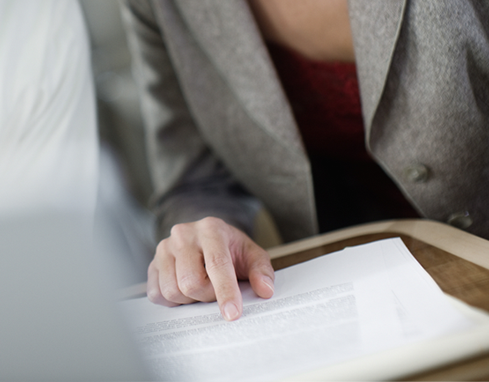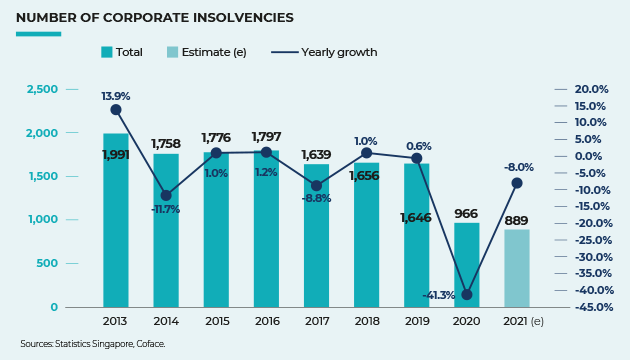

Singapore
Synthesis
MAJOR MACRO ECONOMIC INDICATORS
| 2020 | 2021 | 2022 | 2023 (e) | 2024 (f) | |
|---|---|---|---|---|---|
| GDP growth (%) | -3.9 | 8.9 | 3.6 | 0.9 | 2.0 |
| Inflation (yearly average, %) | -0.2 | 2.3 | 6.1 | 5.1 | 3.2 |
| Budget balance (% GDP) | -10.5 | 0.3 | 0.3 | 0.1 | 0.4 |
| Current account balance (% GDP) | 16.4 | 18.0 | 19.3 | 16.6 | 15.2 |
| Public debt (% GDP) | 146.6 | 136.6 | 167.5 | 167.9 | 168.3 |
(e): Estimate (f): Forecast *Fiscal year from April 1 - March 31
STRENGTHS
- High non-price competitiveness
- High value-added industry (new technologies, finance, chemicals, pharmaceuticals)
- Major goods transport and trading hub (air and sea), financial centre
- Large FDI inflows thanks to the generous tax regime, political stability, and excellent business climate
- Major Asian exporter of capital, mostly through its sovereign wealth funds
WEAKNESSES
- Dependent on exports and imports (energy and food)
- Skilled labour and housing shortages
- Ageing population, relatively high old-age dependency ratio (27%)
- Vulnerable to the structural slowdown of the Chinese economy and to US-China geopolitical tensions
RISK ASSESSMENT
Economy hit hard by global headwinds
In 2023, Singapore’s growth was significantly hampered by slowing global trade, low manufacturing activity, tighter financial conditions, and persistently elevated inflation. High dependence on the export economy will generate faster growth in the next year but will be below trend. This largely reflects expected sluggish global demand in 2024, with a recession risk for the US (Singapore’s fourth-largest goods export market, accounting for nearly 9% of Singapore’s total merchandise exports). The country is also likely to face weak demand from its main trade partner, China (12.4% of goods exports in 2022), which has been struggling to recover since its zero-Covid policy ended in late 2022. This would restrict manufacturing activity, which contracted continuously from October 2022 to August 2023. Having said this, global demand for electronics, one of the country’s biggest manufacturing segments, is likely to recover. As in 2023, sluggish international trade will weigh on services exports through receipts from transportation services (35% of services exports in 2022). Conversely, services exports related to the tourism sector (11% of GDP before the pandemic) will continue to recover in 2024. International arrivals represented 70% of 2019 levels over January-August 2023. Financial and insurance (13.7% of GDP) will continue to be affected by tight monetary policy in the US, and possible global high-risk aversion on back of economic and geopolitical uncertainty. Following the introduction of cooling measures, residential property and rental prices showed signs of stabilising in 2023. While construction activity should expand, boosted by both the private and the public sector, the sector will face additional challenges including increasing dormitory costs and stricter work permit rules for migrant workers.
Inflation is expected to remain much higher than in pre-pandemic years and will be fuelled in part by elevated and probably volatile energy and food prices, and commodities for which the city-state largely relies on imports, as well as a GST rate hike. Nevertheless, inflation will continue to slow, providing some relief to households. In this context, private consumption (30% of GDP) should remain robust. Transfers of low and middle-income households, as well as a tight labour market – the unemployment rate was 1.9% in Q2 2023, one of the lowest on record – would also help support consumption. The Monetary Authority of Singapore, which tightened rates from October 2021 to April 2022, is likely to ease its rate policy amid slow growth and moderating inflation.
Sound financial situation
The current account surplus will narrow in 2024, albeit to a substantial level. A wider primary income deficit, which can be explained by a reduction in receipts of Singaporean residents’ investment abroad – notably portfolio investments, financial derivatives, and other investments – amid weaker global economic activity, will be the reason behind this. Meanwhile, the trade balance, which mostly drives the current surplus, could slightly increase as the gradual recovery of exports will be only partially offset by capital-related imports. Rising foreign tourism inflows will keep driving the expansion of the service balance surplus. On back of this durably large current surplus, foreign reserves will remain at an adequate level (8.6 months of imports in August 2023).
After a large fiscal deficit in 2020 due to Covid-related expenditure, the government posted small surpluses amid the ensuring economic recovery and the gradual lifting of Covid-related spending. Overall expenditure, however, remained hefty due to higher development expenditure – notably transport infrastructure, healthcare, and environment – and the introduction of support measures to help households and business cope with high inflation. In 2024, the government is likely to continue allocating wide resources to tackle long-term economic challenges (ageing of the population, vulnerability to global warming, etc.) and maintain the purchasing power of the most vulnerable households, while aiming to contain public spending. On the revenue side, the additional one-percentage point increase in the Goods and Services Tax (from 8% to 9%) scheduled for 1 January 2024 and faster economic growth is expected to boost tax receipts.
While public debt is high on paper, it is used to create a domestic safe asset market and is mainly composed of long-term bonds and securities. In addition, large reserves built up in the past from previous fiscal surpluses (200-300% of GDP) can be used to fund the rare budget deficits. The banking sector appears vulnerable to real estate, with 21.5% of outstanding domestic loans dedicated to building and construction. However, the sector’s NPL ratio stood at 1.5% in the second quarter of 2023, which is slightly lower than for the totality of commercial bank loans (1.7%), while capital and liquidity buffers remain above regulatory requirements.
Stability and continuity ahead of the 2025 general elections
The People’s Action Party (PAP), which has ruled the country since it gained independence in 1965, remains a dominant ruling party in Singapore’s politics. A disruption to the succession plan after the announcement in 2021 by Deputy Prime Minister Heng Swee Keat’s to step down as leader of the fourth-generation PAP team. Prime Minister (PM) Lee Hsien Loong had planned in 2020 to step aside two years later, but the pandemic delayed his departure. PM Lee named Finance Minister Lawrence Wong as the new leader in 2021, before promoting him Deputy PM. In 2023, the PAP was dogged by political scandals, which are rare in the city-state. Despite the scandals, Lawrence Wong is expected to become PM during the next general elections that are due to be held by 2025. Although the Prime Minister (PM) wields the greatest power in politics, the overwhelming victory by the PAP’s candidate during the presidential election in September 2023 reflects the party’s popularity. Tharman Shanmugaratnam, former Deputy PM, scored 70.4% of the votes.
Last updated: November 2023
Payment
Cheques, cash and bank transfers are all frequently-used means of payment within Singapore. Bank transfers, fast and secure, are widely used for international transactions. Standby Letters of Credits and Irrevocable Letters of Credit are often used in export transactions.
Debt collection
Amicable phase
The amicable phase begins with the seller contacting buyers in writing, by telephone and, where permissible, by visiting the buyer’s business premises. If there is no response from the buyer, a site visit and online searches are conducted to ascertain the operating and legal status of the buyer. If the buyer does not make attempts to settle the matter amicably, legal proceedings can be used to recover payments for goods sold and delivered in Singapore. It is, however, prudent to ensure that the buyer has sufficient assets to satisfy the debt before proceedings are initiated.
Legal proceedings
Singapore is a common law jurisdiction. Its laws are principally governed by Supreme Court of Judicature Acts, State Court Acts, other statutes which have procedural application (or contain procedural provisions), the Rules of Court, practice directions, case law and the court’s inherent powers.
Singapore’s courts comprise State (Subordinate) Courts and the Supreme Court. The Supreme Court is composed of the High Court and the Court of Appeal (the final appellate court). The High Court is a court of first instance, generally used for claims beyond the jurisdiction of the State Courts (although the High Court is a court of unlimited jurisdiction and may hear any claim).
Default Judgment
If a defendant fails to enter an appearance or fails to file a defence within the time specified in the writ, the plaintiff may enter default judgment against him. This can be a final judgment or an interlocutory judgment, depending on the nature of the claim.
Summary Judgment
If the defendant has entered an appearance and filed a defence, but it is clear that the defendant has no real defence to the claim, the plaintiff can apply to court for summary judgment. To avoid summary judgment being entered, the defendant must show that the dispute concerns a triable issue, or that there is some other reason for trial. An application for summary judgment must be filed within 28 days of pleadings being concluded (unless the court orders otherwise).
Enforcement of a Legal Decision
Writs of Execution
A judgment can be enforced by a variety of writs of execution. These include a Writ of Seizure and Sale of movable and immovable property, a Writ of Delivery and a Writ of Distress. These writs authorise court officials to take appropriate measures to give effect to the judgment.
Garnishee Proceedings
This can be an appropriate solution when the debtor is owed a debt by a third party (the garnishee). When the creditor garnishes the debt, the garnishee must then make payments due to him, rather than to the debtor. To collect these debts, the creditor must first apply for a garnishee order nisi. This can be filed without the involvement of other parties and leads to “show cause” proceedings. If the garnishee confirms that there are monies due and owing to the judgment debtor at this stage, the Registrar may proceed to make the garnishee nisi absolute.
Registration of Judgment
If the creditor is not able to enforce his judgment in Singapore, he may be able to enforce it in a country where the debtor holds assets. This can be done by commencing fresh proceedings, or by registering the Singapore judgment in the foreign country (on the basis of reciprocity of enforcement between the two countries).
Insolvency Proceedings
Schemes of Arrangement
Schemes of arrangement begin with an application to court, for an order summoning one or more meetings of the creditors, members of the company, or shareholders of the company. If the court agrees to the order, a proposal must then be tabled before the relevant meetings and approved by the requisite majority (unless the court orders otherwise) of the creditors, class of creditors, members or class of members, shareholders, or class of shareholders.
Judicial Management
When a company is in financial difficulty but has reasonable prospects of being rehabilitated, or if preserving all or part of its business as a going concern (or even that the interests of creditors would be better served than by resorting to a winding up), the company or its creditors can apply to court for an order that the company be placed under the judicial management of a judicial manager.
Liquidation
If an insolvent company is unable to overcome its difficulties, it can be dissolved. This enables the liquidation of its assets, so that creditors can be repaid, at least in part. This process is known as winding up or liquidation. A healthy company can also be subject to winding up if its members no longer wish the business to continue. When a company is wound up, its assets or proceeds are first used to pay off any creditors. Following this, any balance remaining is distributed pro rata amongst shareholders.




